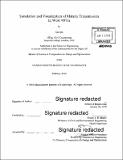Simulation and visualization of malaria transmission In West Africa
Author(s)
Qiu, Xin, S.M. Massachusetts Institute of Technology
DownloadFull printable version (14.67Mb)
Other Contributors
Massachusetts Institute of Technology. Computation for Design and Optimization Program.
Advisor
Elfatih A. B. Eltahir.
Terms of use
Metadata
Show full item recordAbstract
This thesis consists of a simulation-based study and a data visualization framework development focusing on malaria transmission in West Africa. The simulation-based study introduces the concept of hysteresis in malaria transmission, which is defined as the dependence of malaria transmission on initial conditions of the system, characterizing the dry season. The simulation results confirm that the hysteresis effect does exist in malaria transmission demonstrated in the significant effects of initial prevalence and immunity level of the population. The persistence of the hysteresis effect is stronger in a relatively high transmission environment than in low transmission environments. In addition, the study highlights the importance of sustainable malaria control and resource allocation in the reduction of malaria transmission. It illustrates that exposure-reduction malaria control programs like the distribution of insecticide-treated nets (ITNs) will result in a loss of acquired immunity for the population. If the ITN coverage is discontinued after a period of time, relatively strong malaria resurgence will occur. This thesis also presents a web-based mapping and visualization tool for spatio-temporal data like malaria transmission predictions. The framework is developed using open source software and is not only interactive but also web-based; hence, it can deliver spatio-temporal data to the public more effectively than traditional applications. The tool contains the following two main components: the visualization interface and the interactive maps. When the user interacts with the tool, such as clicking on the map, relevant graphics and numerical data will be requested and displayed in the visualization interface. The interactive map, facilitated by animation controls, allows users to view map animations and explore how different climate and malaria transmission data changes over time and space. The visualization framework itself is customizable and has also been used to publish and visualize temperature projections in Southwest Asia.
Description
Thesis: S.M., Massachusetts Institute of Technology, Computation for Design and Optimization Program, 2016. Cataloged from PDF version of thesis. Includes bibliographical references (pages 73-76).
Date issued
2016Department
Massachusetts Institute of Technology. Computation for Design and Optimization ProgramPublisher
Massachusetts Institute of Technology
Keywords
Computation for Design and Optimization Program.